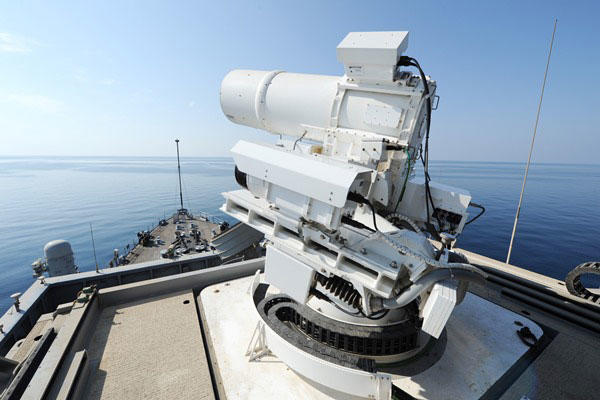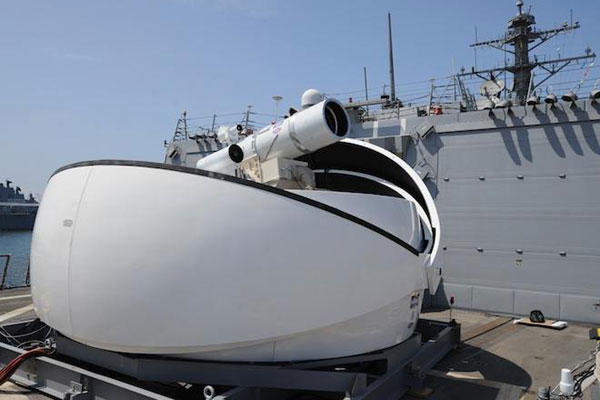The Navy's 30-kilowatt solid-state laser aboard the USS Ponce is now being fired in operational scenarios by sailors in the Persian Gulf, marking the first-ever deployment of a sea-based directed energy weapon.
"We've tested it in the lab we've tested it operationally at sea. Now, we are not testing it anymore. This is operational," said Rear Adm. Matthew L. Klunder, chief of naval research at the Office of Naval Research. "They are using it every day."
If a small or large attack boat, missile or aircraft launched an attack upon the USS Ponce, sailors are equipped to destroy an approaching threat in seconds with the new laser weapon.
"If we had to defend that ship today, it will destroy any threat that comes in-bound. We have the ROE (rules of engagement) to support that," he said.
The Navy's Laser Weapon System, or LaWS, uses heat energy from lasers to disable or destroy targets fast, slow, stationary and moving targets. The system has successfully incinerated drones and other targets in tests shots, and is now operational aboard an amphibious transport dock, the USS Ponce.
The scalable weapon is designed to destroy threats for about 59-cents per shot, an amount that is exponentially lower that the hundreds of thousands or millions needed to fire an interceptor missile such as the Standard Missile-2, Klunder explained.
While at sea, sailors have been using the LaWS for targeting and training exercises every day.
"They've used it to disable and destroy some targets," Klunder said. "The sailors on the ships are using the time with this weapons system to hit fast moving targets, slower targets, ones that are larger and ones that are smaller. They have gone through the paces regarding what they might see in terms of not only speed of the target, but also size of the target."
Navy sailors and engineers have discovered some unanticipated intelligence, reconnaissance and surveillance value from the laser weapons system by using its long-range telescope to scan for targets, Klunder added.
"LaWS is ISR capable. Not only are we using the directed energy to quickly and effectively disable and destroy threats, we've also using it on an everyday basis for targeting and identification of potential threats," He said. "We're picking up things at long ranges with a high degree of resolution. The large aperture telescope provides power and magnification."
Navy leaders said the LaWS system is effectively integrated with the ship's radar systems and weapons such as the Close-In-Weapons-System, or CIWS, a technology designed to fire small interceptors able to defend the ship against approaching enemy fire.
"So far it has exceeded expectations. Went to sea in September and the laser has been operational since. It has been integrated with the ship's navigation systems, radar and Close-In-Weapons System. We put it in a demanding marine environment," said Rear Adm. Bryant Fuller, deputy commander, ship design, Integration and naval engineering at Naval Sea Systems Command.
While laser weapons offer new levels of precision and speed for naval warfighters, Navy officials said they also bring increased safety for ships and crews, as lasers are not dependent on the traditional propellant and gunpowder-based ordnance found on ships. Lasers run on electricity and can be fired as long as there is power.
Klunder said the system is durable and able to function in various weather conditions. He explained that the LaWS functioned extremely well following a dust storm in theater.
Along with analyzing data from the weapon's operational use, Navy officials are also working on a much more powerful, next-generation 100 to 150 kilowatt laser weapon to be ready by 2016 or 2017, Klunder added.
Although future specifics are still being determined, the Navy is confident it will be putting laser weapons on a wide range of ship platforms to possibly include the destroyers, cruisers and the Littoral Combat Ship, among others.
"We've done analytical work and we know what ships we can put it on. Frankly it is a lot of them in the naval inventory. We're talking through which ones we might want to do in the future, specifically those more suited to the higher power 100 to 150 kilowatt laser. That is the one we are really targeting for more extensive use," he said.
-- Kris Osborn can be reached at kris.osborn@military.com































